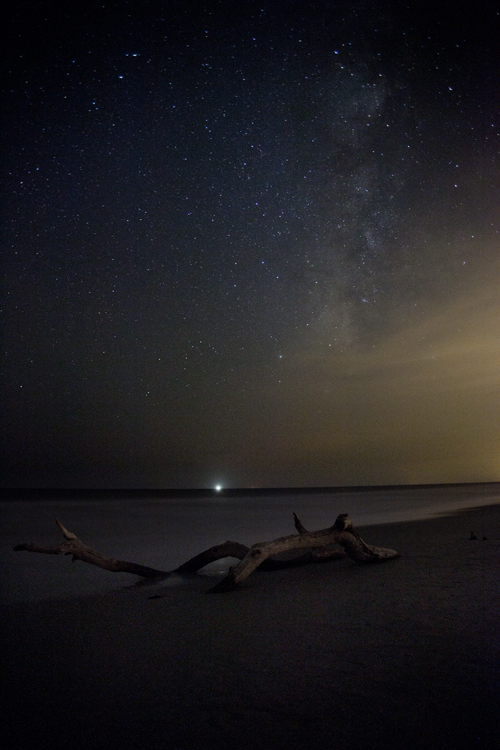
One of the greatest feelings I get is to go out on the beach to photograph during darkness. It would be easy to say it’s the solitude, but it’s so much more than that. The world is a different place after the sun goes down. It’s a different sky; it’s a different beach, even if the ocean is forever the same.
Sometimes luminescent plankton wash to the shore and form a faint glowing line at the edge of the water. Though I know there are sea monsters waiting for the chance to drag me to some place of flesh ripping torment, I don’t mind the risk. This is my beach–my sky.
I know a lot of people sit and read, but if I sit on the ocean’s edge during daytime, I tend to just sit and watch the ever-changing, never-changing seascape. And then darkness comes and I am drawn into this new world, bringing with me a camera, a tripod, a timer and all the wonder that is in my soul.
I recently heard of a book called “The End of Night,” by Paul Bogard. Its author is “searching for natural darkness in an age of artificial light.” I’m pleased that I bought a copy so I could go along on this journey. Since the days I first stepped into darkness to attempt a photograph of Halley’s Comet I have been fascinated by the night sky, as long as it wasn’t too inconvenient or kept me out too late. I bought a telescope and looked at some things from the front yard of my suburban home, with mixed results. The streetlight at the corner of the yard caused me to constantly block the light with a hat.
And that is one of Mr. Bogard’s major points. We live in a time when there is so much artificial light around that we cannot truly see the sky anymore. I had never really thought about this before, but even when I photographed Halley’s Comet (1986-ish) I drove some 30 miles farther out from my home, yet there was still some faint sky glow from the city (not a major city).
It was 4 o’clock in the morning.
Mr. Bogard progresses from the brightest part of the Earth to some of the darkest (and quite endangered). Along the way, we meet people from many different disciplines, not just astronomers, as astronomers are not the only ones who benefit from dark skies. And none of them are against lighting. They are against bad lighting.
This is not just a collection of facts about the dangers of losing the darkness. The facts are woven in an eloquent storytelling style that makes the journey an interesting and worthwhile one. Though sometimes a bit alarming or disturbing, it is always thought provoking: What if the next generation doesn’t understand the song “Twinkle, Twinkle Little Star”?
Mr. Bogard is a college professor. I’ve known many PhD’s and I’ve come to sometimes believe PhD stands for Passion has Died. I’ve seen far too many PhD’s who have had their enthusiasm educated right out of them. Thankfully, Mr. Bogard hasn’t lost his passion for the night sky, nor for telling a good story.
Full disclosure: I read most of it under artificial illumination. I was, however, inside my home.
We often hear about how humanity has influenced its environment in negative ways with regard to pollution of all sorts, but seldom do we consider misdirected light as pollution. The International Dark Sky Association has a website dedicated to information about preserving the night sky, and is dedicated to that task.